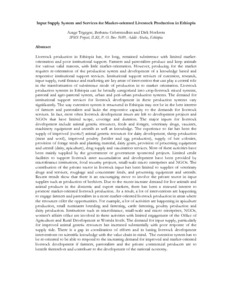Resource information
Livestock production in Ethiopia has, for long, remained subsistence with limited market-orientation and poor institutional support. Farmers and pastoralists produce and keep animals for various valid reasons, with little market-orientation. However, producing for the market requires re-orientation of the production system and development of a knowledge based and responsive institutional support services. Institutional support services of extension, research, input supply, rural finance and marketing are key areas of intervention that can play a central role in the transformation of subsistence mode of production in. to market orientation. Livestock production systems in Ethiopia can be broadly categorized into crop-livestock mixed systems, pastoral and agro-pastoral system, urban and peri-urban production systems. The demand for institutional support services for livestock development in these production systems vary significantly. The way extension system is structured in Ethiopia may not be in the best interest of farmers and pastoralists and lacks the responsive capacity to the demands for livestock services. In fact, most often livestock development issues are left to development projects and NGOs that have limited scope, coverage and duration. The major inputs for livestock development include animal genetic resources, feeds and forages, veterinary drugs, vaccines, machinery equipment and utensils as well as knowledge. The experience so far has been the supply of improved (exotic?) animal genetic resources for dairy development, sheep production (meat and wool), improved poultry (broiler and egg production), supply of bee colonies, provision of forage seeds and planting material, dairy goats, provision of processing equipment and utensil (dairy, apiculture), drug supply and vaccination services. Most of these activities have been mainly supplied, by the government or government sponsored projects. Limited credit facilities to support livestock asset accumulation and development have been provided by microfinance institutions, food security projects, small-scale micro enterprises and NGOs. The contribution of the private sector in livestock input has been limited to supplies of veterinary drugs and services, roughage and concentrate feeds, and processing equipment and utensils. Recent trends show that there is an encouraging move to involve the private sector in input supplies such as production of beehives. Due to the recent increase demand for live animals and animal products in the domestic and export markets, there has been a renewed interest to promote market-oriented livestock production. As a result, a lot of interventions are happening to engage farmers and pastoralists in a more market-oriented livestock production in areas where the resources offer the opportunities. For example, a lot of activities are happening in apiculture production, small ruminants breeding and fattening, cattle fattening, poultry production and dairy production. Institutions such as microfinance, small-scale and micro enterprises, NGOs, women affairs office are involved in these activities with limited engagement of the Office of Agriculture and Rural Development at Woreda levels. The demand for input supply, particularly for improved animal genetic resources has increased substantially with poor response of the supply side. There is a gap in coordination of efforts and in basing livestock development interventions on scientific knowledge with the value chain in mind. The extension system has to be able to respond to the increasing demand for improved and market-oriented livestock development if farmers, pastoralists and the private commercial producers are to benefit themselves and contribute to the development of the national economy.



